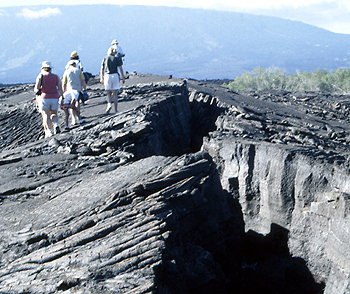The soldier looked again at the terrible landscape—thorny,
dry vegetation, fields of sharp broken lava, and the volcanos, following
each other as far as his dry eyes could see.
Isabela Island, named after Queen Isabela of Spain, called Albermarle
Island by the British, is the largest of the many islands and islets
which make up the Galapagos. Larger, at almost 1,800 square miles, than
all of the other islands put together. Six volcanoes form the backbone
of the island, all but one of which are active, and the island, particularly
the northern part, is wild and rugged.
In 1893, Don Antonio Gil settled on the island on a plantation he called
Villamil. There he dabbled in agriculture and mining, rendered turtle
oil, and exploited feral cattle for their hides. He also exploited the
abundant tortoises, using their shells to decorate the path up to the
plantation.
Thirty miles inland on the slopes of a mountain, he established a second
plantation, Santo Tomas, primarily for mining sulfur from the fumaroles
in the area.
Other plantations sprung up on the island as time went on because of
it´s abundant resources. It was the custom in those days for plantations
such as these to employ workers who were fugitives of the law. This made
discipline on the plantations very harsh. Punishments could include death
or exile, and some plantation owners traded workers for cattle.
As the plantations grew in size and number of workers, the owners petitioned
the government of Ecuador for police and military protection, although
there had been no trouble thus far on the island. In 1902 two small garrisons
were dispatched to the island, consisting of a total of 12 soldiers.
Nothing much happened, and the soldiers became terribly bored. So bored,
in fact, that they decided to secretly leave the island.
In 1904, eleven of the soldiers quietly set out towards the interior
of the island carrying neither water or supplies, certain they would
be able to find a way back to the mainland. The owners of the plantations,
realizing they were gone, searched for days but never found them.
After awhile, they gave up hope and had all but forgotten about the missing
soldiers, when one of them, near death, reappeared at the plantation
entrance. Once nursed back to health, he explained that the soldiers
left thinking that such a big island should be filled with villages,
and that they would be able to find sea transport back to Guyaquil. Overtaken
by hunger and thirst, they began to hallucinate, and eventually separated.
None, except the one survivor, was ever seen or heard from again.
Click Here for information on our Galapagos Tours.


 By
Ellen Klein
By
Ellen Klein
